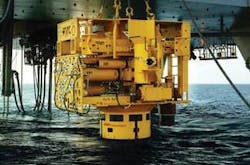SUBSEA/SURFACE SYSTEMS
Gene Kliewer, Houston
Fjord used to “store” subsea template
In a novel approach, subsea templates destined for Statoil’s Tyrihans project are being stored temporarily on the bed of the Åsen Fjord in Norway. The crane vesselUglen shuttled the templates from the port of Trondheim to the fjord and lowered them 55 m (180 ft) to the seabed, where they will stay until Subsea 7’s Botnica construction support vessel retrieves them.
TheBotnica will raise each template through a midships moonpool where it will be suspended for the trip to Tyrihans field in the Halten Bank area of the Norwegian Sea for installation.
“We would have to have used the world’s largest installation vessel if we decided to install the templates from a barge at the field,” says Ståle Gjersvold, Statoil’s Tyrihans project manager. “These vessels are both difficult to get hold of and expensive.”
TheUglen is lighter and more readily available, but is restricted to calmer near-shore waters.
Statoil and partners have invested NOK 14.5 billion ($2.4 billon) in Tyrihans, which is being developed with five templates tied back to the Statoil-operated Kristin field. Statoil’s share ownership in Tyrihans is 46.8%. The other partners are Total with 26.51%, Norsk Hydro with 12%, Eni with 7.9%, and ExxonMobil with 6.75%.
Subsea fiber-optic sensor development planned
An agreement to develop a subsea fiber-optic sensor deployment method is in place between SensorTran and Ocean Design Inc. They will work to install optical sensing fiber through a variety of subsea connectors for the first time. In particular, the development plan includes work on putting the optical sensing fiber in umbilical power cables; on risers, pipelines, and jumpers; and through wellheads.
Combining SensorTran’s temperature sensing and ODI’s subsea interconnect system will provide temperature data necessary for flow assurance. By avoiding wax or hydrate formation, operators can reduce chemical injections, optimize flowline heating, and reduce pigging.
UK continental shelf R&D hot spot
Some 57% of multinational oil and gas companies conduct research and development activities on the UK continental shelf, according to the Aberdeen & Grampian Chamber of Commerce in a study sponsored by Deloitte.
The survey investigated trends in confidence, activity, employment, and investment in R&D since December. Most of the activity centered on “developing processes, improving extraction, and developing related software.” On the downside, 26% of the companies surveyed did no research.
“What is encouraging is that 25% of smaller firms, employing less than 100 people, and 36% of firms with more than 100 employees are reporting an increase in R&D. It is, however, of concern that over a quarter of the contractors surveyed said they did not undertake any R&D,” says Derek Henderson of Deloitte.
Peregrino field pipelines contracted
Partners Hydro and Anadarko have awarded an EPIC contract to Subsea 7 for pipelines on the Peregrino field offshore Brazil, subject to approval by local authorities.
The pipeline will be manufactured in Brazil for installation in 4Q 2009. Peregrino is 85 km (53 mi) offshore in 100 m (328 ft) water depth.
Development will be via an FPSO and two drilling platforms. Projections call for 30 horizontal production wells and seven water injection wells. Production of the estimated 300-600 MMbbl of heavy oil reserves is expected to begin in 2010.
Lithium-ion batteries power FMC subsea controls
FMC Technologies and Saft are working to demonstrate the advantages of using rechargeable lithium-ion (Li-ion) batteries to power electrically operated subsea control valves. The first prototype, with six Li-ion battery modules, is in Statoil’s Norne field at 350 m (1,148 ft) water depth in the North Sea.
“Electrical subsea technology based on rechargeable battery systems is already field-proven, following a successful installation on Statoil’s Statfjord,” says Vidar Sten Halvorsen of FMC Technologies. “The recent development work with Saft has shown that Li-ion battery technology will offer significant benefits in operational performance by enabling us to store much more energy within a compact, lightweight package with high-cycling capability than with traditional cells.”
The Li-ion battery modules developed by Saft in conjunction with FMC comprise seven VL41M cells connected in series, providing nominal 24 V and 800 W capacities. The cells are housed in a nitrogen-filled enclosure to withstand pressure at depth.
The battery modules will be maintained on float charge from the subsea tree’s local 24 V DC supply and will deliver a current of up to 120 A for the high-torque motors that operate the control valves.
On the Norne system, 21 electrically operated actuators are being retrofitted to operate manual (ROV-operated) and electro-hydraulic valves.



